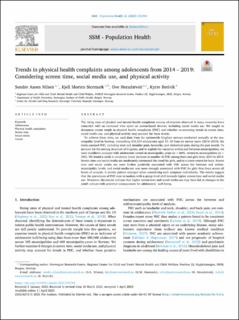| dc.contributor.author | Nilsen, Sondre Aasen | |
| dc.contributor.author | Stormark, Kjell Morten | |
| dc.contributor.author | Heradstveit, Ove | |
| dc.contributor.author | Breivik, Kyrre | |
| dc.date.accessioned | 2023-10-18T13:58:44Z | |
| dc.date.available | 2023-10-18T13:58:44Z | |
| dc.date.created | 2023-05-03T13:19:31Z | |
| dc.date.issued | 2023 | |
| dc.identifier.citation | SSM - Population Health. 2023, 22 1-12. | en_US |
| dc.identifier.issn | 2352-8273 | |
| dc.identifier.uri | https://hdl.handle.net/11250/3097326 | |
| dc.description.abstract | The rising rates of physical and mental health complaints among adolescents observed in many countries have coincided with an increased time spent on screen-based devices, including social media use. We sought to document recent trends in physical health complaints (PHC) and whether co-occurring trends in screen time, social media use, and physical activity may account for these trends. To achieve these aims, we used data from the nationwide Ungdata surveys conducted annually at the municipality level in Norway, comprising 419,934 adolescents aged 13–18 from six survey years (2014–2019). Six items assessed PHC, including neck and shoulder pain, headache, and abdominal pain, during the past month. To account for the nesting structure of Ungdata, and to exploit the variation within and between municipalities, we used multilevel analyses with adolescents nested in municipality-years (n = 669), nested in municipalities (n = 345). We found a small to moderate linear increase in number of PHC among boys and girls from 2014 to 2019. Screen time and social media use moderately attenuated the trend for girls, and to a lesser extent for boys. Screen time and social media use were further positively associated with PHC across the between and within-municipality levels, and social media use was more strongly associated with PHC for girls than boys across all levels of analysis. A similar pattern emerged when considering each symptom individually. The results suggest that the prevalence of PHC rose in tandem with a group-level shift towards higher screen time and social media use. Moreover, the results indicate that higher screen time and social media use may have led to changes in the youth culture with potential consequences for adolescents’ well-being. | en_US |
| dc.language.iso | eng | en_US |
| dc.rights | Navngivelse 4.0 Internasjonal | * |
| dc.rights.uri | http://creativecommons.org/licenses/by/4.0/deed.no | * |
| dc.title | Trends in physical health complaints among adolescents from 2014 – 2019: Considering screen time, social media use, and physical activity | en_US |
| dc.title.alternative | Trends in physical health complaints among adolescents from 2014 – 2019: Considering screen time, social media use, and physical activity | en_US |
| dc.type | Peer reviewed | en_US |
| dc.type | Journal article | en_US |
| dc.rights.holder | © 2023 The Authors | en_US |
| dc.description.version | publishedVersion | en_US |
| cristin.ispublished | true | |
| cristin.fulltext | original | |
| cristin.qualitycode | 1 | |
| dc.identifier.doi | 10.1016/j.ssmph.2023.101394 | |
| dc.identifier.cristin | 2145119 | |
| dc.source.journal | SSM - Population Health | en_US |
| dc.source.volume | 22 | en_US |
| dc.source.pagenumber | 1-12 | en_US |

